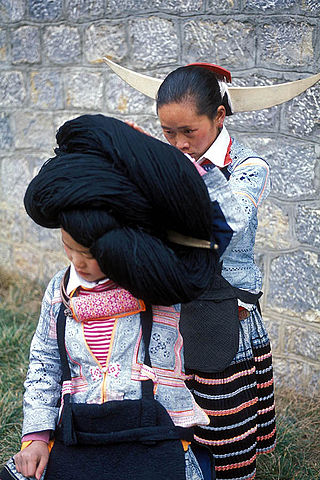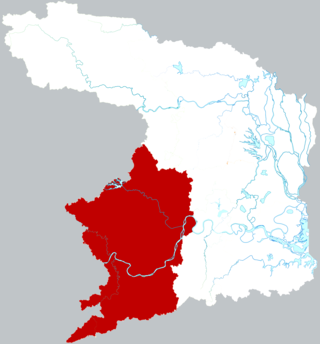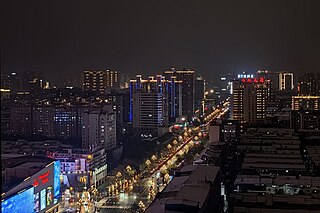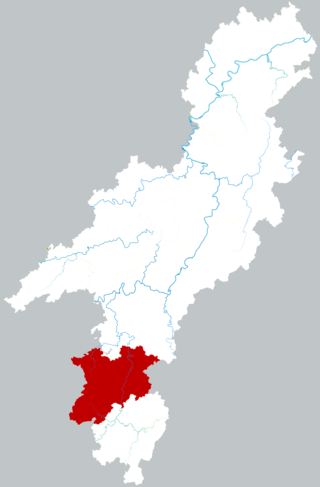Related Research Articles

The Hui people are an East Asian ethnoreligious group predominantly composed of Chinese-speaking adherents of Islam. They are distributed throughout China, mainly in the northwestern provinces and in the Zhongyuan region. According to the 2010 census, China is home to approximately 10.5 million Hui people. Outside China, the 170,000 Dungan people of Kazakhstan and Kyrgyzstan, Panthays in Myanmar and many of the Chin Haws in Thailand are also considered part of the Hui ethnicity.

The Tujia (Northern Tujia: Bifjixkhar / Bifzixkar, IPA:, Southern Tujia: Mongrzzir, ; Chinese: 土家族; pinyin: Tǔjiāzú; Wade–Giles: Tu3-chia1-tsu2) are an ethnic group and, with a total population of over 8 million, the eighth-largest officially recognized ethnic minority in the People's Republic of China. They live in the Wuling Mountains, straddling the common borders of Hunan, Hubei and Guizhou Provinces and Chongqing Municipality.

Hunan is an inland province of China. Located in the middle reaches of the Yangtze watershed, it borders the province-level divisions of Hubei to the north, Jiangxi to the east, Guangdong and Guangxi to the south, Guizhou to the west, and Chongqing to the northwest. Its capital and largest city is Changsha, which abuts the Xiang River. Hengyang, Zhuzhou, and Yueyang are among its most populous urban cities. With a population of just over 66 million as of 2020 residing in an area of approximately 210,000 km2 (81,000 sq mi), it is China's 7th most populous province, the fourth most populous among landlocked provinces, the second most populous in South Central China after Guangdong and the most populous province in Central China. It is the largest province in South-Central China, the fourth largest among landlocked provinces, and the 10th most extensive province by area.

The Miao are a group of linguistically related peoples living in Southern China and Southeast Asia, who are recognized by the government of China as one of the 56 official ethnic groups. The Miao live primarily in the mountains of southern China. Their homeland encompasses the provinces of Guizhou, Yunnan, Sichuan, Hubei, Hunan, Guangxi, Guangdong, and Hainan. Some sub-groups of the Miao, most notably the Hmong people, have migrated out of China into Southeast Asia. Following the communist takeover of Laos in 1975, a large group of Hmong refugees resettled in several Western nations, mainly in the United States, France, and Australia.

Xiangxi Tujia and Miao Autonomous Prefecture is an autonomous prefecture of the People's Republic of China. It is located in northwestern Hunan province. It consists of one city, Jishou, and seven counties: Baojing, Fenghuang, Guzhang, Huayuan, Longshan, Luxi, and Yongshun. Jishou is the capital. Of the 2,480,000 residents, 66.6% are ethnic minorities from 25 different ethnic groups, including 860,000 Tujia and 790,000 Miao.

Taoyuan County is under the administration of Changde, Hunan Province, China. The Yuan River, a tributary of the Yangtze, flows through Taoyuan. It covers an area of 4441 square kilometers, of which 895 km2 (346 sq mi) is arable land. It is 229 km (142 mi) from Zhangjiang Town, the county seat, to Changsha, the capital city of Hunan province. The county occupies the southwestern corner of Changde City and borders the prefecture-level cities of Zhangjiajie to the northwest and Huaihua to the southwest.
Maojia is a mixed language in Southern China. Maojiahua is an unclassified Sinitic language that has undergone influence from Hmongic languages.

Changde is a prefecture-level city in the northwest of Hunan province, People's Republic of China. In addition to the urban districts, Changde also administers the county-level city of Jinshi and six counties. Changde is adjacent to Dongting Lake to the east, the city of Yiyang to the south, Wuling and Xuefeng Mountains to the west, and Hubei province to the north.

During the Manchu-led Qing dynasty (1644–1912), Islam was a significant religion in Northwestern China and Yunnan. There were five major Muslim rebellions during the Qing period. The first and last rebellions were caused by sectarian infighting between rival Sufi Muslim orders.

Semu is the name of a caste established by the Yuan dynasty. The 31 Semu categories referred to people who came from Central and West Asia. They had come to serve the Yuan dynasty by enfranchising under the dominant Mongol caste. The Semu were not a self-defined and homogeneous ethnic group per se, but one of the four castes of the Yuan dynasty: the Mongols, Semu, the "Han" and the Southerners. Among the Semu were Buddhist Turpan Uyghurs, Tanguts and Tibetans; Nestorian Christian tribes like the Ongud; Alans; Muslim Central Asian Turkic peoples including the Khwarazmians and Karakhanids; West Asian Arab, Jewish, Christians and other minor groups who are from even farther west.
Chengbu Miao Autonomous County, usually referred to as Chengbu County or abbreviated just as Chengbu, is an autonomous county of Miao people in the Province of Hunan, China, it is under the administration of Shaoyang City.

Jingzhou Miao and Dong Autonomous County, usually referred to as Jingzhou County or abbreviated just as Jingzhou, is an autonomous county of Miao and Dong peoples in Hunan Province, China, the county is under the administration of the prefecture-level city of Huaihua. It was known as "Jing County", renamed to the present name on February 19, 1987.

The Miao rebellions in the Ming dynasty were a series of rebellions of the indigenous tribes of southern China against the Ming dynasty, from the 14th to the 15th centuries. The Ming defeated the rebels with overwhelming force. Later, during the Qing dynasty, another series of Miao rebellions broke out.

The Miao Rebellion of 1795–1806 was an anti-Qing uprising in Hunan and Guizhou provinces, during the reign of the Qianlong Emperor and Jiaqing Emperor. It was catalyzed by tensions between local populations and Han Chinese immigrants. Bloodily suppressed, it served as the antecedent to the much larger uprising of Miao Rebellion (1854–73).
The Miao Rebellion of 1735–1736 was an uprising of autochthonous people from southwest China.
The Chu Army was a standing regional army organized by Zuo Zongtang. The name is taken from the Hunan region where the Army was raised. The Army was financed through local nobles and gentry, as opposed to the central government.
The Miao rebellion of 1854–1873, also known as the Qian rebellion was an uprising of ethnic Miao and other groups in Guizhou province during the reign of the Qing dynasty. Despite its name, Robert Jenks estimates that ethnic Miao made up less than half of the uprising's participants. The uprising was preceded by Miao rebellions in 1735–36 and 1795–1806, and was one of many ethnic uprisings sweeping China in the 19th century. The rebellion spanned the Xianfeng and Tongzhi periods of the Qing dynasty, and was eventually suppressed with military force. Estimates place the number of casualties as high as 4.9 million out of a total population of 7 million, though these figures are likely overstated.
Hala may refer to:
The Miaojiang Great Wall is a series of fortifications in Southern China. It is located in the present-day Xiangxi Autonomous Region of Tujia and Miao in the western province of Hunan, China. It is a 190-kilometre (120-mile) wall, the largest part of which is in Fenghuang County. It was built in 1554 during the Ming Dynasty to protect against the minorities in Southern China and was completed in 1662. The wall is 3 metres high and 2 metres wide.
Chang'anying is a rural town in Chengbu Miao Autonomous County, Hunan, China. As of the 2015 census it had a population of 8,013 and an area of 260-square-kilometre (100 sq mi). It is surrounded by Zhaishi Miao Ethnic and Dong Ethnic Township on the north, Wanfoshan Town on the west, Dankou Town on the east, Wutuan Town on the southeast, and Pingdeng Town on the southwest. It lies at the border of three provinces of Hunan, Guizhou and Guangxi, which made it even a place of strategic importance in ancient China.
References
- ↑ "Ethnic Uygurs in Hunan Live in Harmony with Han Chinese". People's Daily. 29 December 2000.
- ↑ Chih-yu Shih, Zhiyu Shi (2002). Negotiating ethnicity in China: citizenship as a response to the state. Psychology Press. p. 133. ISBN 0-415-28372-8 . Retrieved 28 June 2010.